#medieval clothing
Text


Medieval Posture ™
#medieval reenactment#medieval#14th century#14th century reenactment#reenactment#medievalcore#costuming#photography#medieval clothing#medieval manuscript#sca#innilgard#i’ll be on my merry way now
304 notes
·
View notes
Text


water-wading boots
illustrations in a technological manuscript, upper rhine, 15th c.
source: Zurich, Zentralbibl., Ms. Rh. hist. 33b, fol. 68v and 155r
#15th century#technical drawings#clothing#medieval shoes#shoes#water#illuminated manuscript#medieval clothing
151 notes
·
View notes
Text
On the left is a sketch idea for royal heir!y/n in their usual royal attire. They're sorta carefree, wearing loose-fitted clothing rather than tight shoes and corsets
On the right is what Sun and Moon looked like before being appointed guards. Note: this is not Eclipse.

#fnaf daycare au#fnaf daycare attendant#fnaf daycare fandom#royal guard!au#fnaf dca#fnaf sun and moon#fnaf sun#fnaf moon#fnaf sundrop#fnaf moondrop#royal heir!y/n#medieval clothing#jester#concept sketch#reference sheet
376 notes
·
View notes
Text

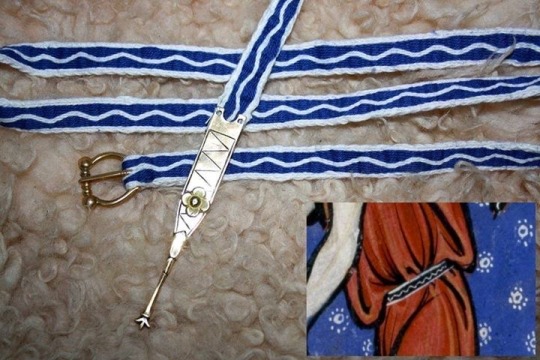
13th century tablet woven belt
#15th century#13th century#medieval#tablet weaving#loom weaving#belt#christianity#reenactment#living history#medieval clothing#reenactor#manuscript
196 notes
·
View notes
Text

I'm sorry, but I was deadass serious I saw Merlin right there; in my grocery store! My heart stopped for a minute.
#bbc merlin#bbc merthur#merlin bbc#merlin#merthur#arthur pendragon#the once and future king#that posture#that clothing#medieval clothing#hair and architecture#how that's not him
187 notes
·
View notes
Text

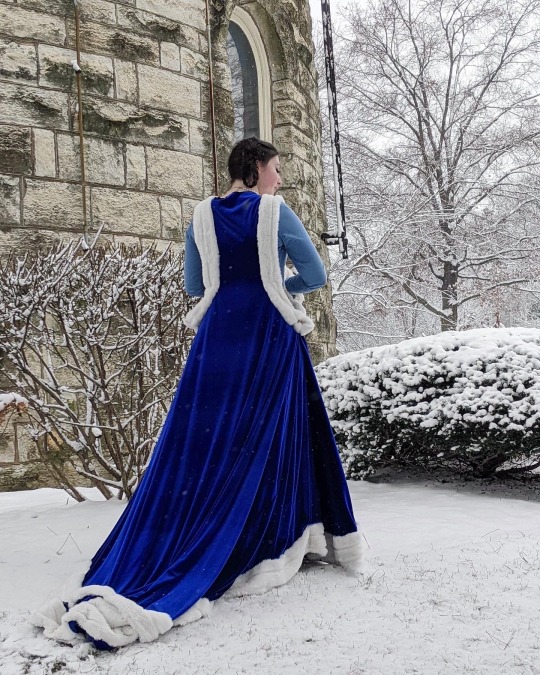
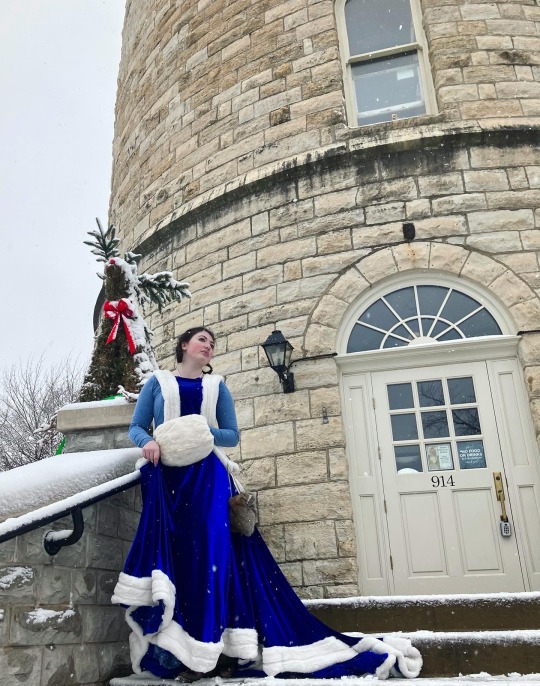

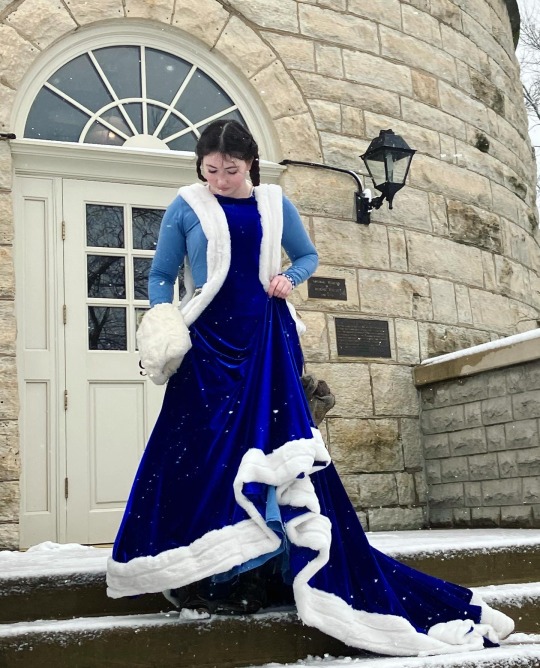
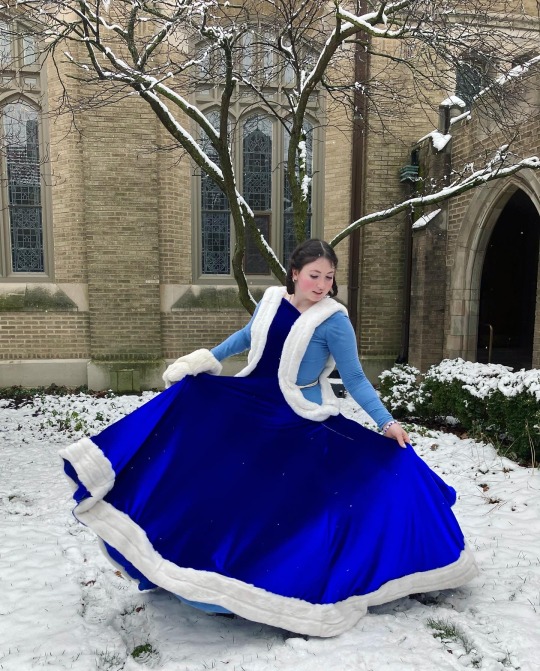
Princess of the Winter Kingdom ❄️💙
I finished this literally the night before my local SCA chapters’ Twelfth Night event but I think it turned out so good, it was so fun to swish around in this dress!
Sideless surcoat made by me, kirtle was thrifted and altered. Rabbit muff is vintage.
#medieval clothing#medieval aesthetic#fourteenth century#princesscore#knightcore#SCA#society for creative anachronism#I’m just sad I didn’t have anything for my head or a matching purse but literally no time left lol#it was SO FUN though omg#I did have to hold it up to walk though lol it is just so long#mine
54 notes
·
View notes
Text
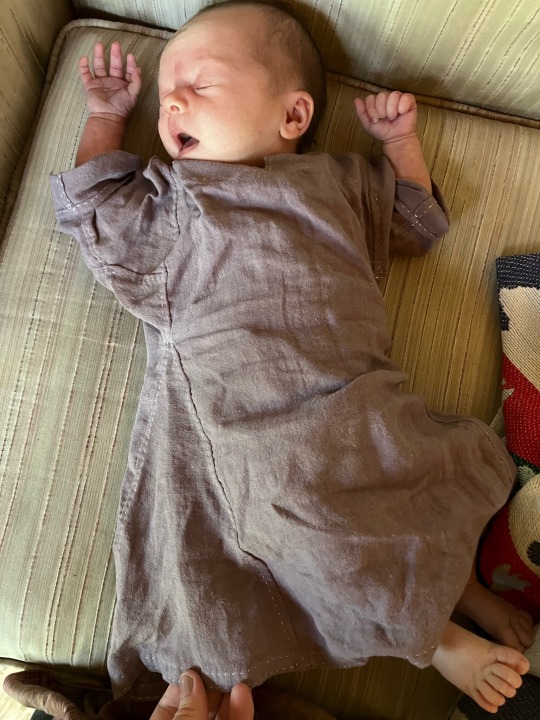
Sometimes pregnancy compels you to do weird things, like sew a medieval gown for your unborn daughter.
This is mauve linen in a style similar to that worn by Viking women as well as the basic cote before it got more fitted and fancy; you can see the side skirt panel and underarm gusset with flat felled seams.
Designed and handstitched by me based on primary and secondary sources.
#costumery#textile arts#creative projects#sewing#history#medieval clothing#harry le fyz#i really need to start actually tracking and sharing my sources but my brain is so damn fried all the time
124 notes
·
View notes
Text
youtube
Getting Dressed in the 14th Century
from CrowsEyeProductions
64 notes
·
View notes
Text







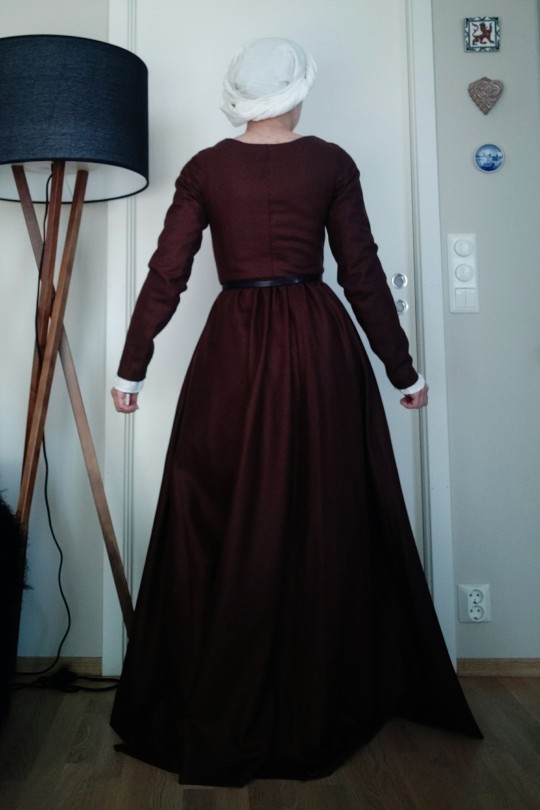

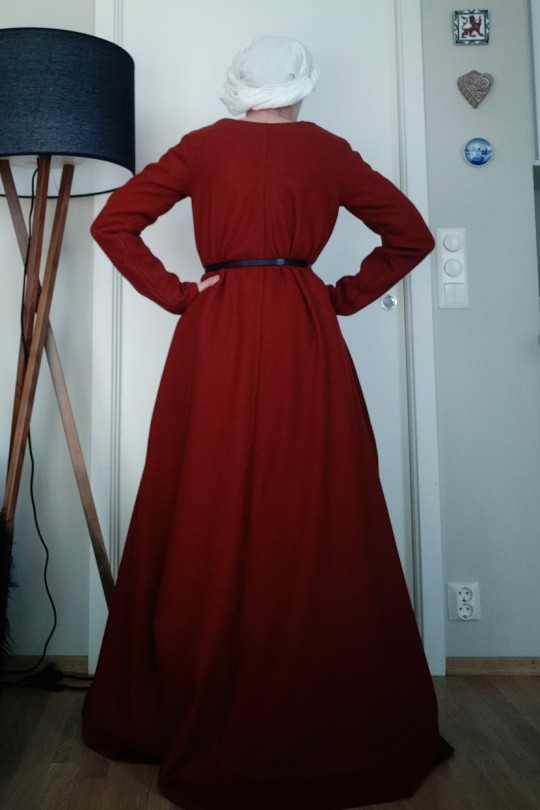
Had to take pictures of my things for an event this summer that I applied for, so here, finally a nice compilation of the things I have made these past two years. I documented all in seperate posts you can find in my pinned post if you like!
#personal#myface#15th century project#sewing adventures#historical reenactment#medieval reenactment#15th century reenactment#late 15th century#medievalcore#medieval clothing#medieval sewing#ignore my face#medieval
182 notes
·
View notes
Photo
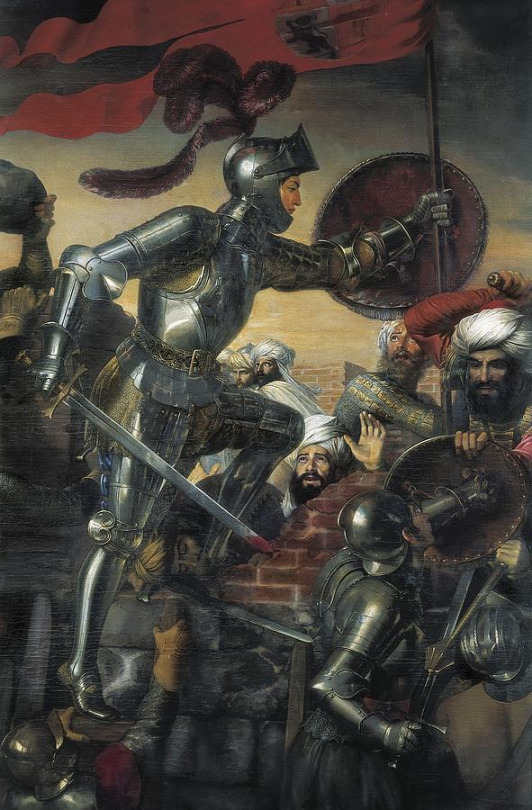
José de Madrazo y Agudo (Spanish, 1781 - 1859)
El Gran Capitán en el asalto de Montefrío, first half of 19th century
Alcázar de Segovia
#José de Madrazo y Agudo#art#spanish art#european art#classical art#world history#historical art#el gran capitan en el asalto de montefrio#fine art#fine arts#knight#medieval#Medieval Times#medieval clothing#spain#espana#europe#european#europa#portrait of male#battle
254 notes
·
View notes
Text

How To Make Medieval Fabric Buttons
You will need:
• fabric (I’m using a medium weight wool)
• a sewing needle
• cotton or silk thread (it MUST be strong)
• a thimble
• dressmakers pins
Using this style of button as a fastening technique was very prevalent in 14th century Europe, on both men’s and women’s clothing. It was used for anything from sleeves and openings on the front of garments, to the iconic liripipe hoods (which is what these are gonna be for!).
They were usually made out of leftover fabric from the same material that was used for the garment they were intended for. As well as using every scrap of material possible, they also save you from having to buy metal buttons, which… aren’t cheap (both now and then).
The trade off is of course having to make them, which can be a painful process (literally - try not to get stabbed by the hedgehog ball at step 4!!). I thoroughly recommend a thimble to push the needle through as you form the ball - this is hard enough without having to pull it through.
Making buttons in my experience is 10% knowledge, 60% spite, and 30% hatred. It is a contest of wills between you (who wants a button) and the fabric (who doesn’t want to be a button). I wish you luck soldier.

To start with, cut a circle out of your fabric. How big will depend on what fabric you use - if it’s linen, you’d cut a larger circle than you would for wool. Mine is about 30mm.
Using a long long thread, bind on and then sew running stitches around the outside, about 5mm from the edge (may vary with fabric).
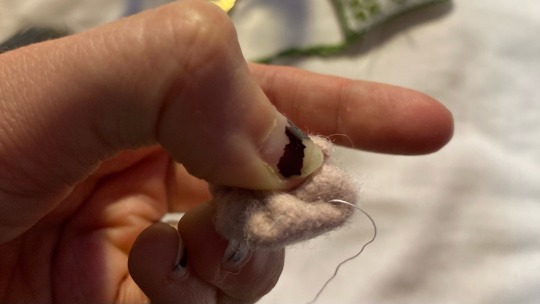
Pull this thread tight like a pouch, and turn the raw edges inwards in one direction. Try and tuck them inside the “bag” section. It will likely be more of a squashed oval at this point than a sphere.

Now, get your dressmakers pins and go absolutely ham. Continue to squish it “inward” (towards where the opening was) as you pin. The button should now resemble a very unfriendly little creature now (good luck with not getting stabbed, it can be a bit of a prick).
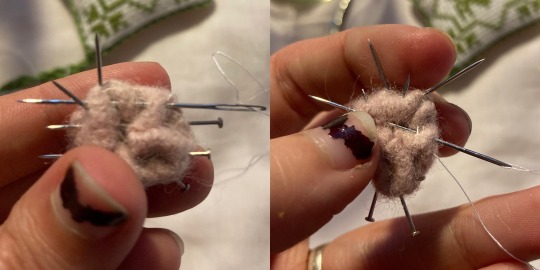
Next, basically use your needle to try and get it to stay in that shape. I usually do a bunch of stitches around the edge of the “back” end, and then spend some time criss-crossing the back. Try and put your needle in close to where it came out, so that you don’t get long pieces of visible thread.
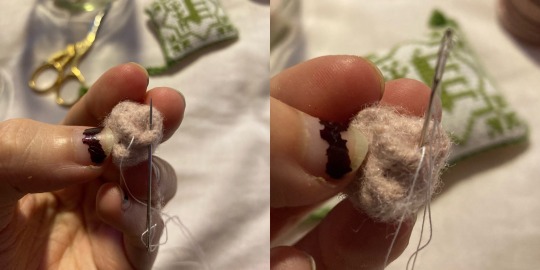
Once you are confident that it will hold A Shape ™ (but also isn’t so stabbed that you can’t refine it further!), remove the pins. Your button will most likely resemble a little tiny messy wool brain at this point, but that’s ok!
The next step is to use your needle and thread to continue tucking the ball inwards to the centre of where the opening was. Above illustrates how I’ll flip the open part of a fold inward, by coming up through the fold and then levering it downwards so it gets tucked away. You can also just use the thread to pull errant folds inwards. Use the hand holding the button to squash it into form, and then sew it into place.
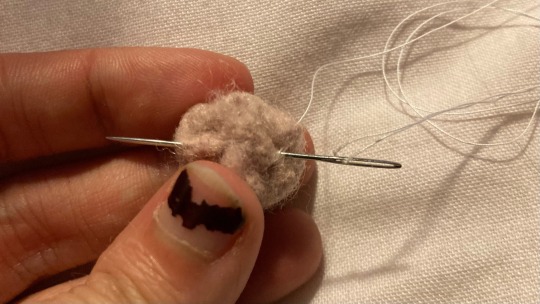
Once the button is actually a ball shape, crisscross the back of it a bit so that everything is firmly held in place. It should now (all things going well!!) actually be a sphere.

Once you’re happy with the shape and firmness, take your thread to stem out of the centre back. Bind off, and then slide the needle off the thread, leaving the long end. This can then be used to sew the button onto the garment.
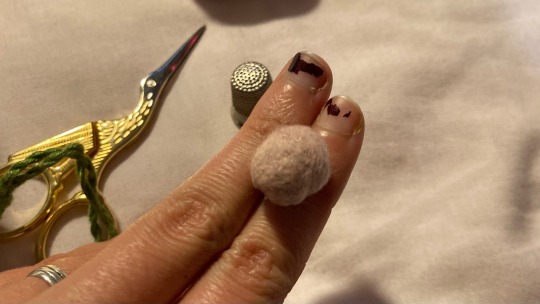
The back will still be somewhat messy, but the front should be smooth, and the whole shape roughly spherical. When the button is sewn on using the remainder of the thread, you won’t be able to see the back!
I wrap the remainder of the thread around the finished button so it won’t get tangled, and then pop it in a jar with the rest while it waits to be sewn onto the garment.
Good luck with your crafting! Feel free to ask any questions in the notes, or straight into my inbox :)
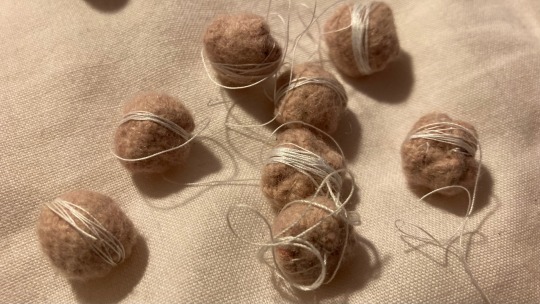
#sewing#tutorial#medieval#medieval reenactment#medieval clothing#medieval costume#historical fashion#historical costuming#medievalcore#14th century#buttons#crafting#diy#i’ll be on my merry way now#I have…… sO many of these to do#truly pain torture and misery hours over here
518 notes
·
View notes
Text
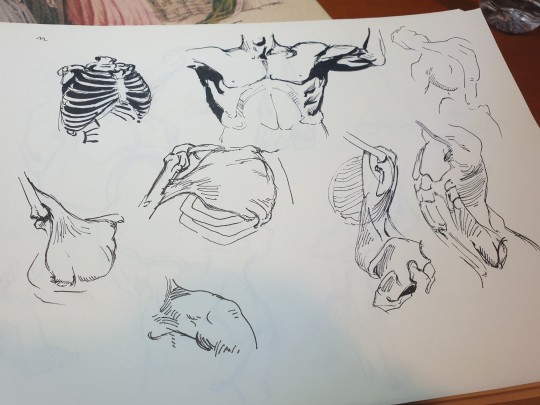



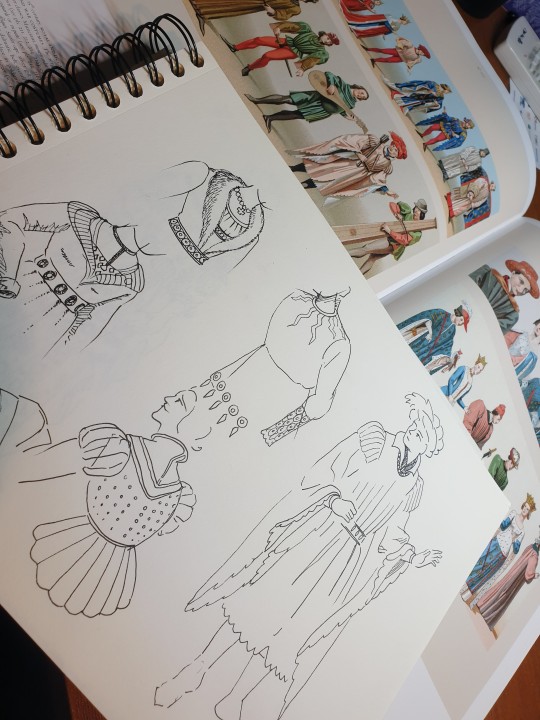
Today I did some study sketches on anatomy and some historical equipment. I haven't done study sketches in a while and it was a nice change of pace. I should also do it more often if I want to improve thought.
#art#sketch#sketchbook#study sketches#anatomy#medieval clothing#historical clothing#historical#swords#medieval weapons
39 notes
·
View notes
Text

And to that, I hold. I would rather share one lifetime with you than face all the ages of this world alone.
(Original photo from medieval festival in Belgrade, Serbia - ig: @sarcasmaddict_ @_witch_king_of_angmar )
#15th century#living history#medieval#reenactment#reenactor#medieval clothing#medieval knight#fantasy#photoshoot#photo edit#princesscore#medieval fashion#medievil#medien#poppy and casteel#medieval painting#medieval period#medieval poetry#medieval peasant#medieval dress#tailoring#sewing#embroidery#fabric#instatumblr#instalike#instagram#aesthetic#lord of the rings
116 notes
·
View notes
Text

Germanic sisters!
#languages i guess#ocs#original character#character design#illustration#my art#digital illustration#gijinka#lig old norse#lig saxon#digital art#medieval#medieval clothing
21 notes
·
View notes
Text
Sewing Medieval Bathhouse Dress
I'm a big boob person and for me bras have always been very uncomfortable. They never support enough even with the metallic wire support as the elastic strap is not secure enough and that wire curve is also just uncomfortable. My shoulders are also always aching because of the pressure put on shoulders. But no bras is even more uncomfortable especially if I have to do anything else than sitting. Which is why I have been considering testing out historical options ever since I got into historical sewing.
When it comes to historical sewing (and to some extent sewing in general) I'm still a noob and so I have been quite intimidated by stays and corsets and I've figured I'll start with medieval supportive garments, like kirtle, as they are much simpler. Then I saw the video where Morgan Donner made a bathhouse dress and I immediately wanted to test it out too.
Some history
Bathhouse dress is a garment that appears around 14th to 16th century in central Europe, mostly around Bohemia, Austria and German states and their vicinity. Perhaps the most famous finding of this garment is the Lengberg Castle Bra found in Austria.
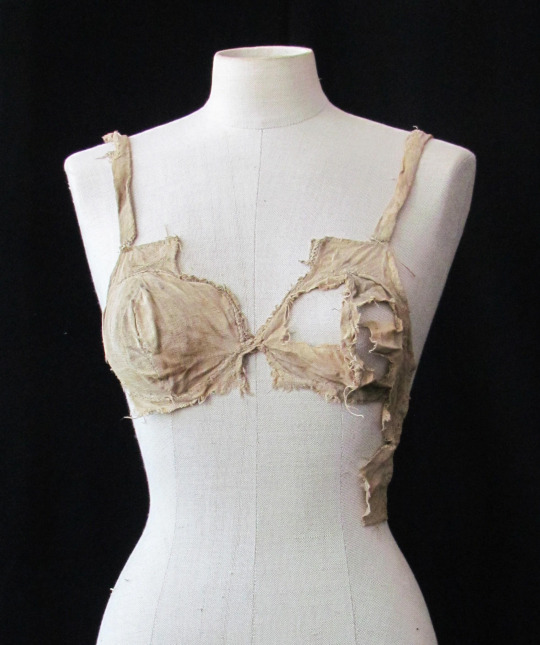
It's often called medieval bra because it has cups like bra. I think that's somewhat misleading as it was a full dress and this is just fragments of the dress. There's theory that there's only this left because the larger continuous pieces of linen were cut off and used for some other garment. The dress was quite different from shift, the usual loose undergarment that would be used under supportive kirtle around most of Europe at the time. It was sleeveless and tailored with lacing, usually on the side. The reason it's often called bathhouse dress is that there's a lot of depictions of it in bathhouse use, especially in Bohemia, and these depictions are sometimes referred as Bohemian bathhouse babes.
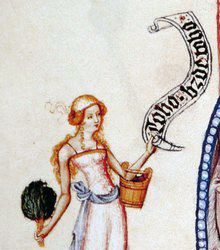
All of these types of garments didn't have cups like this example from 1389 Bohemia, and there were a lot of different designs. There's different shaped bodices, some had waist seem, some didn't. In German the garment with cups was called breastbag at the time. In the literary mentions there was often degrading tone when talking about it, and it seemed that the writers at least thought women who used breastbag were "showing off". When have men not complained about women's fashion in a patriarchal society? Perhaps with the other designs there wasn't similar derision. The writings and some other depictions of the garment suggest that it was used more generally as an undergarment and not just for bathhouse. Which would make sense as it would seen uncharacteristic for Middle Ages to tailor a supporting garment (not cheep) just to use in bathhouses.

Here's a potter wearing similar garment with different design from late 15th century Austria.

Another one from mid 15th century Austria of a woman putting clothes on and obviously wearing the dress as undergarment.

Here's a German example from late 15th century of a woman wearing it as a nightgown, which shift was also used for.
The sewing part
If you want a tutorial, go and watch that Morgan Donner video linked in the beginning, I'm not a good source on sewing, especially historical.
I wanted to make my version of the dress fairly historical, but I wasn't too concerned with making in exactly right as it's purpose is for daily use and not historical costuming. I hand-sewed it with historical techniques though, but the patterning part was quite chaotic and I basically came up with it as I went so there ended up being some weirdness in finishings as I didn't plan far enough.
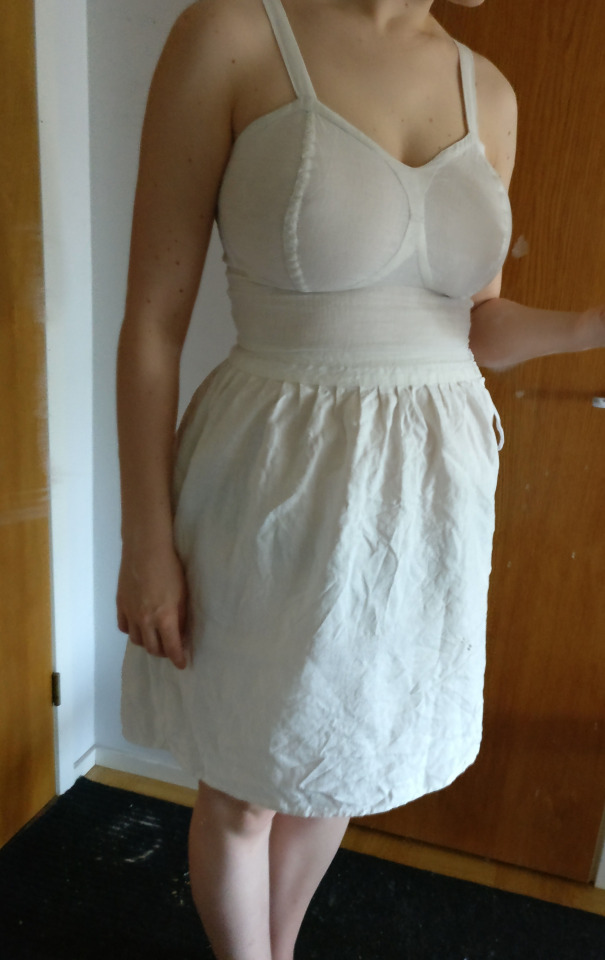
So here's how it turned out. I very intentionally made it much shorter than it should be. Most depictions have it reach half calf. I was making it for daily use and not historical costuming and I have a lot of knee length skirts, so I wanted it short enough for that. I actually made the bodice and skirt into separate pieces that are just loosely whipstitched together so I can use them both alone too, especially the bodice with trousers.

The shape of the bodice isn't historical. The cleavage goes fairly high and is fairly straight in most of the historical examples (especially with the cups). Even the Lengberg bra originally had crochet covering the chest area. But again that wouldn't have fitted so well with a lot of my modern clothing, and my purpose wasn't historical recreation.
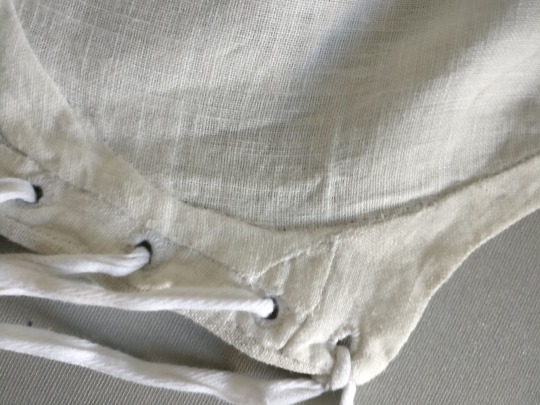
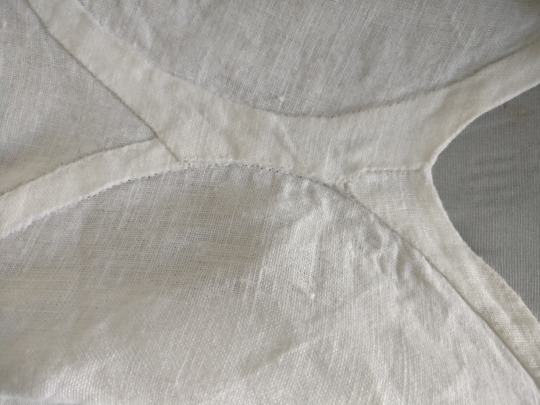
As I was talking about the pretty weird finishings, here you can see them. The result isn't very neat, but it's fine.
I have been wearing this now a couple of months and I'm in love with it. It's much more supportive while being also so much more comfortable. The lacing on the side distributes the force around the waist, so it doesn't put nearly as much pressure on my shoulders. It's made entirely out of linen and is very nice against skin and as it doesn't have any metallic wires it also doesn't press anywhere. It also is just much more flattering than bras at least for me. It doesn't work that well without the skirt, the waist starts wrinkling and moving up, but the skirt keeps it pretty straight. The bodice is also slightly too long and it doesn't sit exactly on my waist, so it adds to the problem. It's not a huge problem though, it's just a bit annoying.
I'm planning to test out a version where I'll reinforce the eyelets with synthetic baleen instead of cord and put baleen in the other side too and maybe in the center front so I could use it as a separate undergarment without the annoying wrinkling. I'm also planning on doing 16th century kirtle bodice or the full kirtle (or both maybe as separate but attachable pieces, like with the bathhouse dress) with either stiff interlining or boning and Regency short stays. I want to test out different types of supportive undergarments in my quest for better bra options. Maybe after I've done them I'm ready to try Victorian corset too.
#historical fashion#historical sewing#sewing#history#fashion history#historical clothing#dress history#bathhouse dress#medieval clothing#medieval fashion#historical undergarments#medieval#am sewing#my creation
566 notes
·
View notes
Text



I went to the Renaissance Fair in Colorado and had an absolute blast!!!
This is a different styling of the dress I made for my Yennefer cosplay— it’s drafted from the excellent book “The Medieval Tailor’s Assistant” :) it’s mostly accurate to the late 14th century
That’s also where I learned to braid and pin my hair in this style to be worn with my simple and veil
My shoes are landsknecht- which are accurate for a slightly later date but I got them from Boots by Bohemond who puts real soles on them (which I need because I wear these over concrete sometimes)
I’m thinking a little next? :)
53 notes
·
View notes